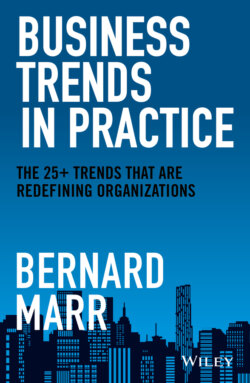Читать книгу Business Trends in Practice - Бернард Марр, Bernard Marr - Страница 25
Trend 4: Artificial Intelligence
ОглавлениеThe fact that our world is increasingly driven by data has brought about incredible leaps in artificial intelligence (AI). Data is a core enabler for AI, in the sense that the more data intelligent machines have to learn from, the better they become at spotting patterns, extracting insights, and even predicting what may happen next.
AI is developing at such an incredible pace that today's intelligent machines are now capable of carrying out a wide range of tasks previously reserved for humans. We have machine vision, where intelligent machines can “see” and interpret images or the world around them; natural language processing, where machines can learn to understand human language; natural language generation, where machines can generate human-like responses; and robotic process automation, where business processes are automated by software robots. To put it in everyday terms, AI is behind self-driving cars, facial recognition technology, recommendation engines, fraud detection, the content that shows up on your social media feed, and more. In 2020 alone, smart speakers answered 100 billion voice commands – 75 percent more than in 2019 – all thanks to AI.9 This “conversational AI,” where machines can use language with human-like accuracy, has made huge breakthroughs in recent years.
One of the most exciting recent advances in this vein is the GPT-3 AI. Created by OpenAI, a research company founded by Elon Musk, GPT-3 is better at creating any content that has a language structure – whether a human language or machine language – than any AI that has come before it. GPT-3 can answer questions, write essays, translate languages, summarize long pieces of text, take memos, and even create computer code. In one demo, GPT-3 created an app similar to Instagram – demonstrating how AI could play a huge role in software and app development in future.
Crucially, AI gives intelligent machines the ability to learn from data and make decisions, sometimes without human intervention. This is where the terms machine learning and deep learning come from. If we think of AI as the umbrella term, machine learning and deep learning are cutting-edge disciplines of AI that both involve getting machines to learn in the same way as humans do (i.e., by interpreting the world around us, sorting through information and learning from our successes and failures). Deep learning is the more advanced of the two because you can simply feed a deep learning system data and let it work out for itself how to find patterns.
One thing that hasn't yet been achieved is the idea of general AI, or the hypothetical ability of machines to understand the world as well as humans and learn any task. This is the AI of sci-fi movies and books. For now, AIs tend to carry out specific, narrow tasks. But just because general AI hasn't been achieved yet doesn't mean it's impossible. General AI is certainly the goal of several AI companies, and I suspect that if we put all the existing AIs together, they would be able not only to match what humans can do, but even exceed it.
That's why I believe AI is one of the most powerful developments we've seen as humans – matched only by gene hacking (more on this coming up). The takeaway for businesses is that, as our interactions with machines become increasingly intelligent, customers will expect all manner of products and services to feature some sort of AI capability. Then there is the potential for AI to enhance your internal business processes, whether it's through automation or helping human workers carry out their work and make decisions more effectively. In other words, every business is going to have to get smarter.
